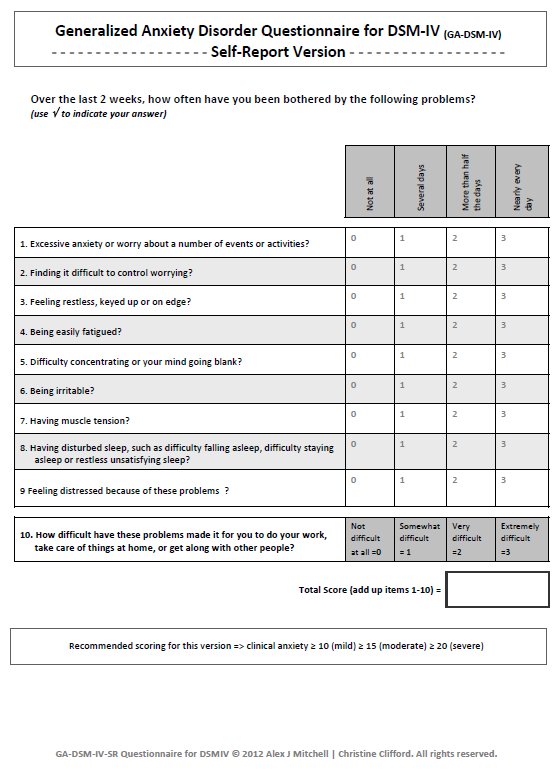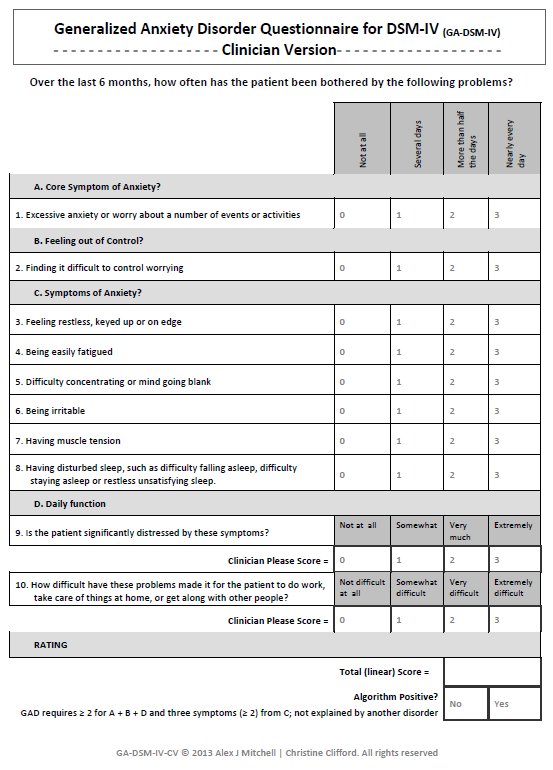
The Test Anxiety Inventory for Children and Adolescents (TAICA) is a new multidimensional measure used to assess test anxiety in elementary and secondary school students. The TAICA is a 45-item self-report measure consisting of a Total Test Anxiety scale, four debilitating test anxiety subscales (Cognitive Obstruction/Inattention, Physiological Hyperarousal, Social Humiliation, and Worry), a facilitating test anxiety scale (Performance Enhancement/ Facilitation Anxiety), and a Lie scale. In the present study, the psychometric properties of the TAICA scores are examined with a volunteer sample of 206 children and adolescents. Results of the study indicate that the TAICA scores have strong to very strong internal consistency reliability and temporal stability (1- to 3-week test-retest interval). Evidence supporting the construct validity of the TAICA scores was found.
Anxiety Inventory Pdf Kids
| Alpert, R. , & Haber, R.N. (1960). Anxiety in academic achievement situations. Journal of Abnormal and Social Psychology, 61, 207-215. Google Scholar | Crossref | Medline | ISI |
| American Psychiatric Association. (2000). The diagnostic and statistical manual of mental disorders (4th ed.; text rev.). Washington, DC: Author. Google Scholar |
| Beidel, D.C. , & Turner, S.M. (1988). Comorbidity of test anxiety and other anxiety disorders in children. Journal of Abnormal Child Psychology , 16, 275-287. Google Scholar | Crossref | Medline | ISI |
| Benjamin, M. , McKeachie, W.J. , Lin, Y.G. , & Holinger, D.P. (1981). Test anxiety: Deficits in information processing. Journal of Educational Psychology , 73, 816-824. Google Scholar | Crossref | ISI |
| Benson, J. (1998). Developing a strong program of construct validation: A test anxiety example. Educational Measurement: Issues and Practice, 17(1), 10-22. Google Scholar | Crossref |
| Berger, V.F. , Munz, D.C. , Smouse, A.D. , & Angelino, H. (1969). The effects of item difficulty sequencing and anxiety reaction type on aptitude test performance. Journal of Psychology: Interdisciplinary and Applied, 71, 253-258. Google Scholar | Crossref | ISI |
| Carver, C.S. , & Scheier, M.F. (1991). A control-process perspective on anxiety. In R. Schwarzer & R. A. Wicklund (Eds.), Anxiety and self focused attention (pp. 3-8). London: Harwood. Google Scholar |
| Casbarro, J. (2005). Test anxiety and what you can do about it: A practical guide for teachers, parents, and kids. Port Chester, NY: Dude. Google Scholar |
| Cassady, J.C. (2004). The influence of cognitive test anxiety across the learning-testing cycle. Learning and Instruction, 14, 569-592. Google Scholar | Crossref | ISI |
| Chapell, M.S. , Blanding, Z.B. , Silverstein, M.E. , Takahashi, M. , Newman, B. , Gubi, A. et al. (2005). Test anxiety and academic performance in undergraduate and graduate students. Journal of Educational Psychology, 97, 268-274. Google Scholar | Crossref | ISI |
| Covington, M.V. (1992). Making the grade. Cambridge , UK: Cambridge University Press. Google Scholar | Crossref |
| Engel, G.L. (1977, April 8). The need for a new medical model: A challenge for biomedicine. Science, 196, 129-136. Google Scholar | Crossref | Medline | ISI |
| Everson, H.T. , Millsap, R.E. , & Rodriguez, C.M. (1991). Isolating gender differences in test anxiety: A confirmatory factor analysis of the Test Anxiety Inventory . Educational and Psychological Measurement, 51, 243-251. Google Scholar | SAGE Journals | ISI |
| Fan, X. , & Thompson, B. (2001). Confidence intervals about score reliability coefficients, please: An EPM guidelines editorial. Educational and Psychological Measurement, 61, 517-531. Google Scholar | ISI |
| Feldt, L.S. (1990). The sampling theory for the intraclass reliability coefficient. Applied Measurement in Education, 3, 361-367. Google Scholar | Crossref |
| Friedman, I.A. , & Bendas-Jacob, O. (1997). Measuring perceived test anxiety in adolescents: A self-report scale. Educational and Psychological Measurement, 57, 1035-1045. Google Scholar | SAGE Journals | ISI |
| Hancock, D.R. (2001). Effects of test anxiety and evaluative threat on students' achievement and motivation. Journal of Educational Research, 94, 284-290. Google Scholar | Crossref | ISI |
| Hembree, R. (1988). Correlates, causes, effects, and treatment of test anxiety. Review of Educational Research, 58, 47-77. Google Scholar | SAGE Journals | ISI |
| Joiner, T.E. , Steer, R.A. , Beck, A.T. , Schmidt, N.B. , Rudd, M.D. , & Catanzaro, S.J. (1999). Physiological hyperarousal: Construct validity of a central aspect of the tripartite model of depression and anxiety. Journal of Abnormal Psychology, 108, 290-298. Google Scholar | Crossref | Medline | ISI |
| Kamphaus, R.W. , & Frick, P.J. (2002). Clinical assessment of child and adolescent personality and behavior (2nd ed.). Boston : Allyn & Bacon. Google Scholar |
| Kamphaus, R.W. , & Reynolds, C.R. (2002). Reynolds Intellectual Screening Test. Odessa, FL: Psychological Assessment Resources. Google Scholar |
| Kirkland, K. , & Hollandsworth, J. (1980). Effective test taking: Skills-acquisition versus anxiety-reduction techniques. Journal of Counseling and Clinical Psychology, 48, 431-439. Google Scholar | Crossref | Medline | ISI |
| Liebert, R.M. , & Morris, L.W. (1967). Cognitive and emotional components of test anxiety: A distinction and some initial data. Psychological Reports , 20, 975-978. Google Scholar | SAGE Journals | ISI |
| Lowe, P.A. , Lee, S.W. , & DeRuyck, K.A. (2004). An exploratory factor analysis of a new comprehensive measure of test anxiety: The Test Anxiety Inventory for Children and Adolescents (TAICA). Unpublished manuscript. Google Scholar |
| McDonald, A.S. (2001). The prevalence and effects of test anxiety in school children. Educational Psychology, 21, 89-101. Google Scholar | Crossref |
| McIlroy, D. , Bunting, B. , & Adamson, G. (2000). An evaluation of the factor structure and predictive utility of a test anxiety scale with reference to students' past performance and personality indices. British Journal of Educational Psychology , 70, 17-32. Google Scholar | Crossref | Medline | ISI |
| Methia, R.A. (2004). Help your child overcome test anxiety & achieve higher test scores. College Station, TX: Virtual Bookwork.com Publishing. Google Scholar |
| Morris, L.W. , & Liebert, R.M. (1969). Effects of anxiety on timed and untimed intelligence tests: Another look. Journal of Consulting and Clinical Psychology , 33, 240-244. Google Scholar | Crossref | Medline | ISI |
| Mueller-Hanson, R. (2002). Impression management strategy and faking behavior in the self-report measurement of personality. Dissertation Abstracts International, 63(5), 2634B. Google Scholar |
| National Center for Education Statistics. ( 2003). Overview of public elementary and secondary schools and districts: School year 2001-2002. Washington, DC: Institute of Education Sources, U.S. Department of Education. Google Scholar |
| Nielsen, I.L. , & Moore, K.A. (2003). Psychometric data on the Mathematics Self-Efficacy Scale. Educational and Psychological Measurement, 63, 128-138. Google Scholar | SAGE Journals | ISI |
| Pela, O.A. , & Reynolds, C.R. (1982). Cross-cultural application of the Revised Children's Manifest Anxiety Scale: Normative and reliability data of Nigerian primary school children. Psychological Reports , 51, 1135-1138. Google Scholar | SAGE Journals | ISI |
| Piedmont, R.L. , McCrae, R.R. , Riemann, R. , & Angleitner, A. (2000). On the validity of validity scales: Evidence from self-reports and observer ratings in volunteer samples . Journal of Personality and Social Psychology, 78, 582-593. Google Scholar | Crossref | Medline | ISI |
| Rafferty, B.D. , Smith, R.E. , & Ptacek, J.T. (1997). Facilitating and debilitating trait anxiety, situational anxiety, and coping with an anticipated stressor: A process analysis. Journal of Personality and Social Psychology, 72, 892-906. Google Scholar | Crossref | Medline | ISI |
| Reynolds, C.R. (1985). Multitrait validation of the Revised Children's Manifest Anxiety Scale for children of high intelligence. Psychological Reports, 56, 402. Google Scholar | SAGE Journals | ISI |
| Reynolds, C.R. (2001). Professional manual for the Clinical Assessment Scales for the Elderly. Odessa, FL: Psychological Assessment Resources. Google Scholar |
| Reynolds, C.R. , & Kamphaus, R.W. (1992a). Behavior Assessment System for Children-Self-Report of Personality. Circle Pines, MN: American Guidance Services. Google Scholar |
| Reynolds, C.R. , & Kamphaus, R.W. (1992b). Behavior Assessment System for Children-Self-Report of Personality manual. Circle Pines, MN: American Guidance Services. Google Scholar |
| Reynolds, C.R. , & Kamphaus, R.W. (2002). Reynolds Intellectual Screening Test manual. Odessa, FL: Psychological Assessment Resources Google Scholar |
| Reynolds, C.R. , & Richmond, B.O. (1978). What I think and feel: A revised measure of children's manifest anxiety. Journal of Abnormal Child Psychology, 6, 271-280. Google Scholar | Crossref | Medline | ISI |
| Reynolds, C.R. , & Richmond, B.O. (1985). Revised Children's Manifest Anxiety Scale manual. Los Angeles: Western Psychological Services. Google Scholar |
| Reynolds, C.R. , Richmond, B.O. , & Lowe, P.A. (2003). Adult Manifest Anxiety Scales manual. Los Angeles: Western Psychological Services. Google Scholar |
| Sarason, I.G. (1978). The Test Anxiety Scale: Concept and research. In C. D. Spielberger & I. G. Sarason (Eds.), Stress and anxiety (Vol. 5, pp. 193-216). Washington, DC: Hemisphere. Google Scholar |
| Sarason, S.B. , Davidson, K.S. , Lighthall, F.F. , Waite, R.R. , & Ruebush, B.K. (1960). Anxiety in elementary school children. New York: Wiley. Google Scholar | Crossref |
| Schwartz, G.E. (1982). Testing the biopsychosocial model: The ultimate challenge facing behavioral medicine? Journal of Consulting and Clinical Psychology, 50, 1040-1053. Google Scholar | Crossref | Medline | ISI |
| Spence, J.T. , & Spence, K.W. (1966). The motivational components of manifest anxiety: Drive and drive stimuli. In C. D. Spielberger (Ed.), Anxiety and behavior (pp. 291-326). New York: Academic Press. Google Scholar |
| Spielberger, C.D. (1972). Conceptual and methodological issues in anxiety research. In C. D. Spielberger (Ed.), Anxiety (Vol. 2, pp. 481-493). New York: Academic Press. Google Scholar | Crossref |
| Spielberger, C.D. (1980a). Test Anxiety Inventory. Palo Alto, CA: Consulting Psychologists Press. Google Scholar |
| Spielberger, C.D. (1980b). Test Anxiety Inventory manual. Palo Alto, CA: Consulting Psychologists Press. Google Scholar |
| Spielberger, C.D. , & Vagg, P.R. (1995). Test anxiety: A transactional process model. In C. D. Spielberger & P. R. Vagg (Eds.), Test anxiety: Theory, assessment, and treatment (pp. 3-14). Washington, DC: Taylor & Francis. Google Scholar |
| Sub, A. , & Prabha, C. (2003). Academic performance in relation to perfectionism, test procrastination and test anxiety of high school children. Psychological Studies, 48, 7-81. Google Scholar |
| Swanson, S. , & Howell, C. (1996). Test anxiety in adolescents with learning disabilities and behavior disorders. Exceptional Children, 62, 389-397. Google Scholar | SAGE Journals | ISI |
| Taylor, J.A. (1956). Drive theory and manifest anxiety. Psychological Bulletin, 53, 303-328. Google Scholar | Crossref | Medline | ISI |
| Tobias, S. (1979). Anxiety research in educational psychology. Journal of Educational Psychology, 71, 573-582. Google Scholar | Crossref | ISI |
| Watson, D. , & Clark, L.A. (1984). Negative affectivity: The disposition to experience aversive emotional states. Psychological Bulletin, 96, 465-490. Google Scholar | Crossref | Medline | ISI |
| Wilkinson, G.S. (1993a). Wide Range Achievement Test-Third edition. Wilmington, DE: Wide Range. Google Scholar |
| Wilkinson, G.S. (1993b). Wide Range Achievement Test-Third edition manual . Wilmington, DE: Wide Range. Google Scholar |
| Wine, J. (1971). Test anxiety and direction of attention. Psychological Bulletin, 76, 92-104. Google Scholar | Crossref | Medline |
| Wren, D.G. , & Benson, J. (2004). Measuring test anxiety in children: Scale development and internal construct validation. Anxiety, Stress, and Coping: An International Journal, 17, 227-240. Google Scholar | Crossref | ISI |
| Yerkes, R.M. , & Dodson, J.D. (1908). The relation of strength of stimulus to rapidity of habit-formation. Journal of Comparative and Neurological Psychology, 18, 459-482. Google Scholar | Crossref |
| Zeidner, M. (1998). Test anxiety: The state of the art. New York: Plenum. Google Scholar |


Test Anxiety Inventory Spielberger
THE EFFECT OF MEDITATION ON ANXIETY IN SPORT SUBMITTED TO SATISFY THE REQUIREMENT FOR THE. Competition Anxiety Test (Thai version), the Competitive State Anxiety Inventory-2 (Thai version) and the perceived uncertainty and the perceived. Many situations create anxiety, either in work, sport, or life in general.